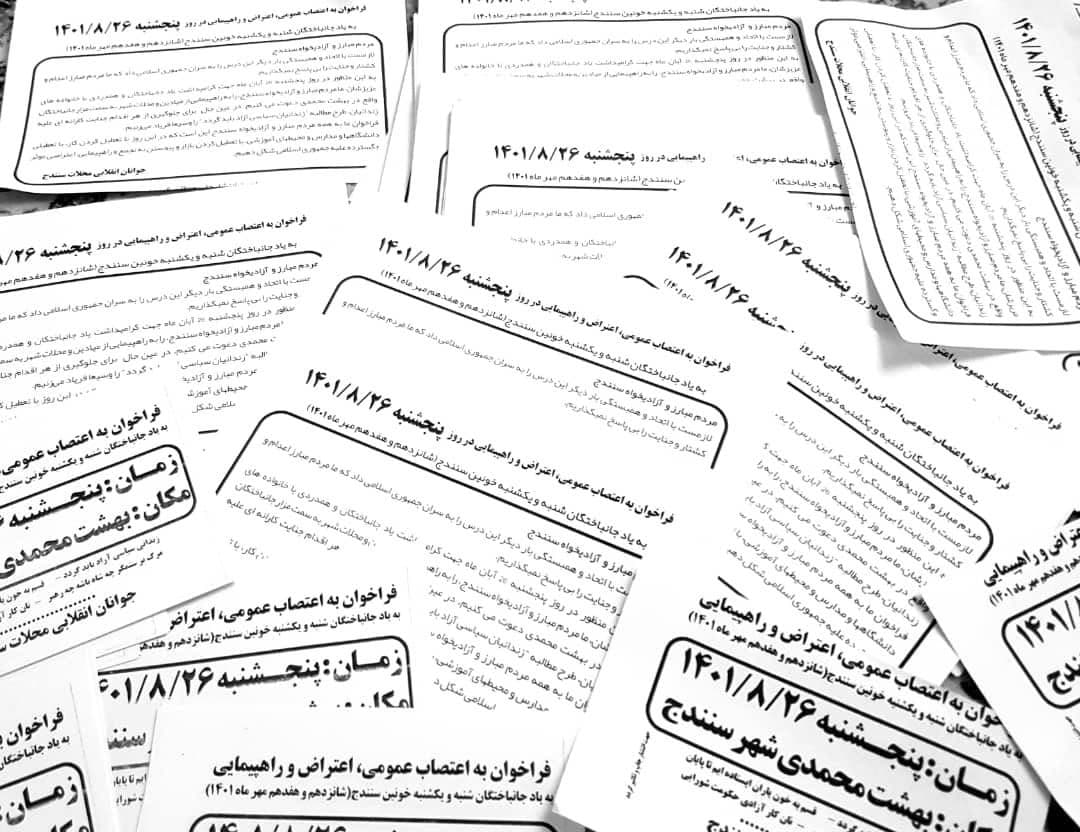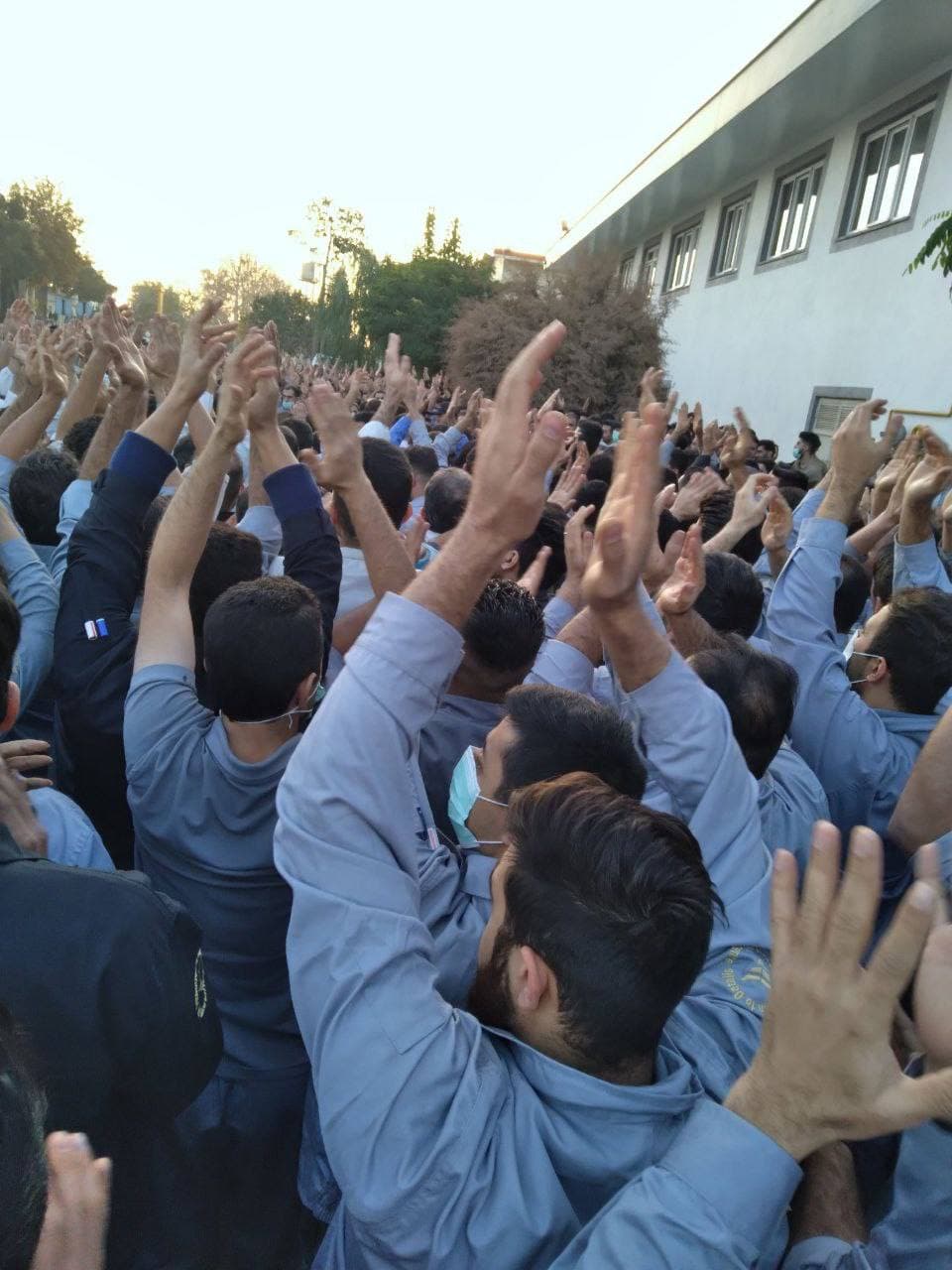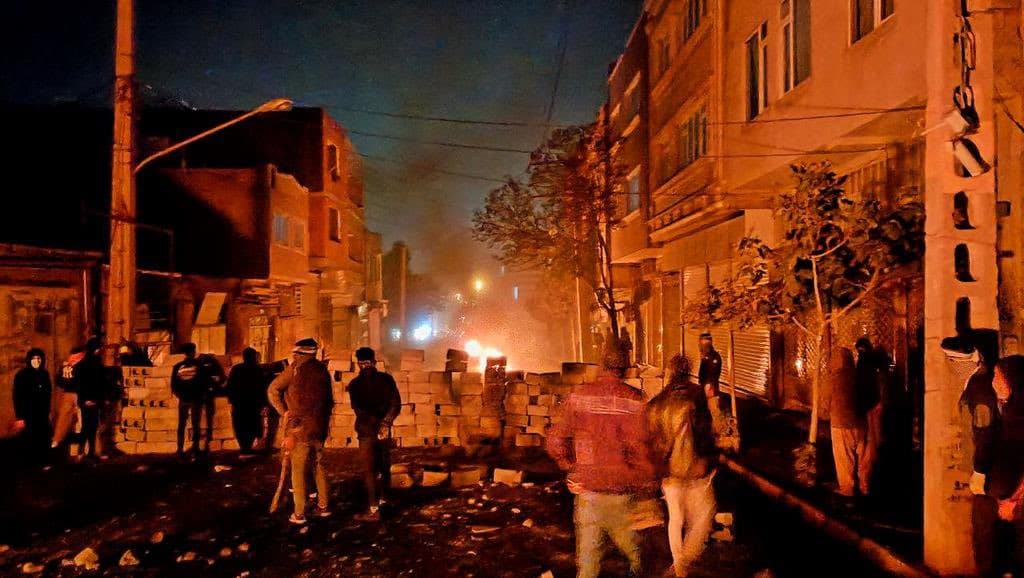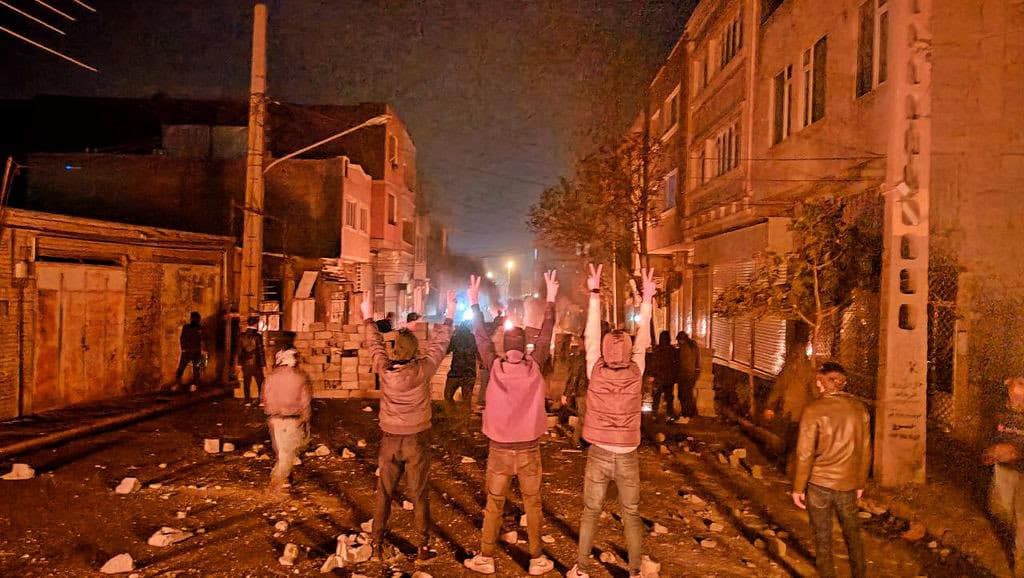Over two months since the beginning of the revolutionary uprising of Iranian youth, following an ebb under heavy repression, a new round of protests took place between 16-19 November, which show the whip of counter-revolution driving the movement forward. For final victory to be achieved, there must be mass, organised participation by the working class!
The previous slogans of “Women, life, freedom”; “Death to the dictator”; “Death to tyrants – be they the Shah or [supreme] leader” continue to be used. But new slogans have been added, such as: “By the blood of our comrades, we will stand up til the end”, and: “Poverty and corruption will endure until we overthrow you.” The most militant protests are in Tehran, Tabriz, and the cities in Khuzestan, including Izeh, Abadan and Ahvaz; and the Kurdish-majority towns such as Mahabad, Saqqez and Sannadaj. The latter have again stood out as the most revolutionary, with general strikes breaking out once more, and violent clashes driving out the security forces. Barricades have been set up, and mountain passes and roads between the towns have been blocked.
At the head of the struggling young people of Marivan, Mahhabad, Saqqez, Sannadaj and others, are the revolutionary youth neighbourhood committees (shuras). These organisations are inspired by the workers’ councils and neighbourhood committees of the 1979 revolution. Aside from the main slogans of the wider youth movement, they have raised slogans from 1979, including: “Bread, work, freedom”, along with the new slogan: “Neither mullahs or shah – for a shurah government”. While a positive development, we should not exaggerate the influence of these councils, which does not extend beyond these radical youths to wider layers of society.
In Tabriz, students have rallied outside the universities, adding a new slogan: “From ‘67 to Aban – Iran is covered in blood”, referring to the mass execution of left wingers in 1988 (1367 in the Persian calendar), and the more recent 2019 uprising (which began in the month of Aban of the Persian calendar). The historic Bazaar of Tabriz has also been completely shut down by strike action.
In Tehran and the surrounding areas such as Karaj and Arak, large rallies have taken place at a few universities. But the most striking events have been the violent clashes at the barricades, with molotov cocktails becoming once again commonplace, with the youth driving out the security forces from parts of the city.
In Khuzestan, students at Ahvaz and Abadan universities shouted the slogan: “From Zahedan to Tabriz – poverty, corruption and descrimination.” In Ahvaz, Abadan and Izeh, barricades have also been set up, and youths have beaten back the security forces from parts of these cities too. In the town of Izeh, the youth completely drove out the security forces. These street protests are significant as they involve numbers of working-class youths.
#IranRevolution2022—November 16, Day 62
— Iran News Update (@IranNewsUpdate1) November 16, 2022
Khuzestan, SW #Iran—Students of the Abadan University of Medical Sciences were seen continuing the nationwide protests against the regime.#MahsaAmini🌹pic.twitter.com/UcEqiQ3ynD
Prior to these events, November saw an ebb in what has been dubbed by many the ‘Mahsa Uprising’. Faced with the most radical uprising in the history of the Islamic Republic, the regime has escalated its repression in the last few weeks. In total, since the start of the uprising, officially 15,000 protestors have been detained and over 370 murdered by the regime, but real numbers are expected to be double, if not triple this figure.
Faced with such repression, the youth uprising was reduced to symbolic protests: attacks against regime buildings and symbols, anti-regime graffiti, and small rallies of predominantly students. Those participating in these small protests were easy to identify and faced expulsion by the university administrations, as well as disappearances from their dormitories.
But as we have seen previously, the whip of reaction prepared the ground for a new upsurge, this time based on the various revolutionary youth organisations established in October. These organisations began preparing the ground for new protests on the anniversary of the crushed 2019 uprising, referred to as Bloody November [Aban in the Persian calendar].
The regime had clearly taken the opportunity to regroup and was seeking to claw back lost terrain by mobilising the security forces to repress this latest wave of protests. East Kurdistan, especially Mahabad, was once again turned into a warzone, with the regime turning off electricity and internet to ensure there are no witnesses to its brutal repression.
But these methods backfired. Starting Sunday, a near-complete general strike broke out in the Kurdish-majority towns with the revolutionary youth committees spreading. Students across Iran have been met with hard repression, with universities essentially being occupied by the security forces. But already there are calls for protests to rally behind the Kurdish revolutionaries.
Inspired by the revolutionary uprising of the youth, economic strikes have broken out including by: Phase 19 of the South Pars petro-chemical company in Bushehr, the Masjid Sulaiman petrochemical company in Khuzestan, Bahman Motors in Karaj, and the Isfahan iron foundry among others. Most significantly, a political strike has begun in Tehran among truck drivers and other workers at the Akbar Abad cargo terminal, with workers shouting the slogans: “We are together – don’t be scared,” and “Death to the dictator”.
اسلامشهر تهران
— Iranworkers (@iranworkers) November 22, 2022
تظاهرات کارکنان و رانندهها در ترمینال باربری اکبرآباد با شعار #مرگ_بر_دیکتاتور pic.twitter.com/diYnvJAXTM
Workers and youth unite! Turn the uprising into a revolution!
The youth continue to show an enormous amount of courage and revolutionary anger against the regime. However, this alone is not enough to bring it down. The youth have repeatedly driven out the security forces from towns and neighbourhoods in the cities, only for the regime to retake these areas through ever-more brutal repression. The youth have been distributing flyers calling for workers to join the movement, and for a nationwide general strike / Image: Fair Use, Telegram
The youth have been distributing flyers calling for workers to join the movement, and for a nationwide general strike / Image: Fair Use, Telegram
This constant back and forth threatens the continuation of the uprising, as young people cannot indefinitely fight a battle against the regime that is unwinnable until they break their isolation. It is only the working class that can overthrow the Islamic Republic, by immobilising society, and overwhelming the security forces. Since October, the youth have been calling for workers to join the movement, and for a nationwide general strike, distributing flyers to this effect containing workers’ demands. The most advanced layer of the youth, organised in revolutionary committees, have already concluded that this is necessary. Prior the most recent protests on 12 November, a joint statement was circulated by students and revolutionary youth organisations from across Iran:
“We stand together, because only through this unity will the final victory of our revolution be possible!
“Workers, teachers, retirees, farmers, nurses, doctors and, in a word, all those who share our grievances: the glorious time to become one, our time to unite, has come. We all already understand that this government does not represent the people of our country! We resisted whatever they told us to do; we did not bow down to the regime, the Sharia ruler, or its many tools of repression.
“We students shouted: ‘We are the children of the workers, we will stay side by side with them.’ A fire inside us burned when we heard the news of the oil strikes. We could not sleep when the teachers were brazenly called ‘spies’ . When the farmers’ right to water was taken away and they came under fire from the security forces, it was like we were being shot also. We university students of medical science felt as though we died along with doctors and nurses when they said, ‘the Basij and the mullahs will show the medical staff how to deal with COVID-19!’ When the Morality Police beat women, we students actively removed the hijab to say: ‘we do not accept subjugation, and Inequality must be ended! Yes, we have been and are with you, because we know that either we will all be free, or none of us will! Because the freedom of each of us is tied to the freedom of all of us.
“Wherever we have been able, we have raised our fists along with the oppressed and exploited: we regard their victories as our victory, and their defeat as our own defeat! But now it is time for the final battle. Now it is time for every movement to unite with the popular revolution, to be turned into a terrible threat to the regime.
“We are sure that you also consider yourself entirely aligned with the current revolution, that you are among its founders, and you gave everything to the field of struggle. You have been and are present on the streets, you have supported the revolutionary movement of the people and participated in the revolution in many ways. We know the place and value of the teachers' strike; the treatment of the wounded of the revolution by the medical staff; the significant presence of workers in the struggle; and the solidarity of the drivers, photographers, shopkeepers and all other sectors in our people's revolution.
“Now it is time to take another step forward. We, university and school students all over the country, ask you to implement decisive strike and protest measures at a national level to accompany the protests at this stage of our revolution. Our revolution needs your active presence and decisive role to create a nationwide strike.
“Undoubtedly, we will celebrate the victory of this revolution together. That day is near and we hope to realise a free, equal, prosperous society for all; a secular and humane society; we will not retreat an inch until we achieve our aspirations.
“Tabriz Student Coalition,
Isfahan Progressive Students,
Organisation of Revolutionary Students of Tehran
Students from:
Khorasan Azad University, University of Research Sciences,
Yadgar Imam Azad University,
Mahabad Azad University,
Ashrafi Isfahani University,
Isfahan University,
Payam Noor Shahr Ray University
Tabriz University
Isfahan University of Medical Sciences
Sanandaj University of Medical Sciences
Isfahan University of Technology
University of Kurdistan
Students of Koi Talab schools in Mashhad
Students of schools in the Imam area of Yazd
Mamsani Conservatory students
Conservatory students in Semnan
Hakim Sabzevari Sabzevar University.”
The Gilan revolutionary committee, an openly communist group, goes further explaining that:
“The fact is that the popular and revolutionary movement of Iran, with all its ups and downs, and despite the heavy costs it has paid so far, is still moving forward and trying to complete its tasks against this rabid and oppressive government, but it is not clear how long such a process will take. But it can be said that the movement of the oppressed doesn't have a professional army [which we could take to mean a revolutionary leadership]. An important point that should be mentioned here is that, in addition to all the courage and sacrifices from the men and women, and especially from the youth, involved in this struggle, the task of this movement will not be accomplished on the streets alone. For without the ranks of the united and organised workers, joining through labour strikes, the revolutionary movement will not reach its final goal.”
As noted, many independent workers’ organisations have made statements in solidarity with the uprising and threatened a political strike including: truck drivers, oil workers, the Teachers’ Coordinating Committee, the Tehran Bus Company workers, the Ahvaz steel workers, among others. Despite this, a national general strike hasn’t broken out, and the few political strikes we have seen have been isolated and thereby swiftly suppressed by the regime, which has led to hesitation among these workers’ organisations to fully commit.
The Teachers’ Coordinating Committee has again reiterated support for the uprising and even openly denounced the regime, but in face of growing repression of the regime against the youth on 19 November they called for strike action for 20-21 November. In isolation, these strikes will be met with the same repression as their previous solidarity strike. The contract oil workers are silent, which is unsurprising following their attempts to spark a political strike among oil workers on the 10 October, and their planned strike on 29 October; which were met with harsh repression.
The revolutionary Haft Tappeh sugarcane company workers are openly calling for protests, the overthrow of the regime and undoubtedly participating in the protests. They have also stressed the need for political strikes against the regime. In a statement signed by them, the Committee for Coordination of the Establishment of Workers’ Organisations, and the Group of United Retirees, we read the following:
“Workers’ unity is key in the struggle!
“The unity of industrial workers, workers in various service fields, and in agriculture is a very important turning point in the working-class movement and will play a decisive role in the advancement and evolution of protests and protest movements throughout Iran. We support any effort to organise and participate in the rightful protests of the working people, and we consider it our duty to advance this struggle.
“In a continuation of the uprisings of previous years, now it has been almost two months, a huge movement among women, youth (especially students), teachers, workers, retirees and all oppressed and working class, with strength and determination, goes on. The breadth and depth of this movement can be heard through the cries of the protesting masses, as they aimed their political slogans at the very foundations of this regime from the first day. The protesters who are out on the streets are still determined to continue the struggle, despite naked repression by the police and security forces, alarming the oppressors.
“The disgraceful record of governments, officials and organisations defending the regime support the continuation of nothing but corruption, theft, high prices, unemployment, worsening poverty, homelessness, imprisonment, torture, executions and killings. Working people have only experienced poverty and inequality, while the ruling capitalists and those enmeshed with the government have enjoyed prosperity, comfort, luxury and wealth. Workers and toilers have not had any share of the social wealth. Throughout the lifetime of the Islamic Republic, real wages – i.e. the real purchasing power of workers - has decreased and is now many times below the poverty line. Even these pathetic wages are only given so the worker can survive to continue being exploited. Of course, millions of unemployed and job seekers have been deprived of even this. The protest, hatred and anger raised in the recent movement are the answer to oppression and boundless exploitation, spreading their heavy shadow over the lives of the workers and toilers without interruption for all these years.
“The people have reached the conclusion that, when government policies and economic programmes don’t give them the faintest glimmer of hope, and act against the interests of working people, they must stand up against it and struggle to change their own destinies by fighting this regime.
“Resistance to the government’s actions in various economic, social and cultural fields is the first step towards jointly changing our destiny and that of society. But this is not enough. For a fundamental change in the society, appropriate methods should be prepared for that change. No government guilty of this level of transgression and corruption, tyranny and lying, with all these forces and means of repression at its disposal, has been easily forced to withdraw from political power. Only an organised struggle, with clear goals and properly prepared, can force the government to retreat, and prepare the ground for the toiling people to take control of their own destiny.
“In a society whose political and economic structure is against the interests of the people, and in which the wishes of the vast majority of the people are suppressed, where they do not enjoy any political and civil freedom, a huge mass of explosive potential builds up, that no repressive government has the power to stop. The reality is that this explosive potential must be transformed into organised and actual power. Becoming a strong and efficient force is only possible through the unity of the oppressed people, the unity of the workers, toilers, women and youth.
“Now, this unity has been established to some extent, at least in terms of participation in actions and street protests by the different sections of society who share the same fate. They have shown they trust each other and respond positively to the calls for protest issued by various groups and leading circles, and in practice are fighting shoulder-to-shoulder in the field of struggle.
“But at the level of the whole society and for the movement to gain more strength now and in the future, the role and position of the working class in these protests is of great importance. The working class, as the largest and most-important section of society, which has the power to stop production and close the economic arteries of capitalist rule, knowing its economic position and exercising its own political will, will be able to lead the process of struggle against capitalist rule to transform society for the benefit of the deprived masses. The position of workers in production, especially in key economic centres, means they can undoubtedly threaten the capitalist economic and political system of the Islamic Republic with just one command to stop production. With the unity of workers of various fields, and other toilers and layers of the oppressed, they will be able to accelerate the revolutionary democratic transformation of society and change their own destinies.”
The Haft Tappeh workers once again are completely correct, and other revolutionary workers and youth must echo this call.
The need for revolutionary leadership!
Since the end of October, many of these new, revolutionary youth organisations have issued joint statements and calls to protest – an important development in the coordination of the struggle. Only the formation of such organisations has allowed the movement to persist.
 The only way forward for the Iranian masses is to abolish capitalism and take power for themselves / Image: Fair Use, Telegram
The only way forward for the Iranian masses is to abolish capitalism and take power for themselves / Image: Fair Use, Telegram
Despite these important steps, however, the task of turning the uprising into a revolution remains to be solved. While the youth have formed organisations, and even linked them up to some extent nationally, every call to protest or for political strikes rests on the mere hope that they will spread spontaneously into a revolutionary general strike. Yet instead of this we have seen a prolonged, bloody revolutionary process for both the youth and the revolutionary workers alike. Further periods of reaction will be inevitable until the youth and workers are united under a revolutionary programme and leadership.
Such a development requires a revolutionary programme. The youth have raised many slogans, which connect with the sympathies of the workers. But the regime has skillfully exploited the fears of the masses. The western imperialists’ campaign of feigned solidarity with the Iranian masses, and the way they advance the hated Pahlavis as an alternative, has only given ammunition to the propaganda of the regime, which paints the entire movement as an imperialist intervention.
The Iranian masses don’t necessarily believe the lies of the regime, but in the absence of a clear alternative, they are fearful of what the fall of the Islamic Republic would entail. The western imperialists also have a brutal history in repression of workers and communists, exploitation, and coups d’etat in Iran and beyond. This history is deeply ingrained in the consciousness of the masses. And the Islamic Republic exploits this fact to the fullest extent. The masses see how western imperialism turned revolutions in the Middle East into sectarian civil wars before, in Syria for instance, whilst propping up brutal dictatorships elsewhere, such as the Saudis.
Winning over the working class is not simply a question of the revolutionary youth and workers shouting louder in their calls for a general strike. Rather, the working class as a whole cannot be won by slogans alone, but only through a concrete revolutionary programme. Such a programme would link the economic demands to democratic demands and the call for the overthrow of the Islamic Republic. This would include reversal of all austerity measures, living pensions and wages, freedom of speech, assembly and press, particularly for trade unions, and the election of a constituent assembly based on neighbourhood committee and workers’ councils to abolish the Islamic Republic. Any programme would have to be further developed by the masses themselves.
Based on such a minimum programme the revolutionaries would rapidly unite the working class and poor. But capitalism in Iran is underdeveloped and the ruling class cannot afford significant economic or democratic reforms. The only way forward for the Iranian masses is to abolish capitalism and take power for themselves through the shuras.
A new revolutionary period
The past two months are incomparable with anything in recent years in terms of their manifestation of the bottomless depths of revolutionary anger. The youth have formed revolutionary organisations calling for a general strike. They have begun attempting to weld together their struggle with that of the revolutionary workers. This is a qualitative leap, building upon the experiences of strikes, protests and uprisings since 2018.
 The past two months are incomparable with anything in recent years in terms of their manifestation of revolutionary anger / Image: Fair Use, Telegram
The past two months are incomparable with anything in recent years in terms of their manifestation of revolutionary anger / Image: Fair Use, Telegram
Despite the harsh repression, the regime is incredibly weak, and has become weaker with every upsurge of the masses since 2018. Its last drops of moral authority have evaporated. The regime can no longer easily divide the masses, as the events of the class struggle have proven that no faction of the regime has anything to offer but corruption, poverty and violence. This has led the regime to become more dependent on repression. But the masses are losing their fear of this too. This leaves the regime in an untenable position. Their only meagre lifeline is the lack of a clear alternative.
The development of the shuras into mass, fighting bodies of the revolutionary working class and youth – linked up at a local, regional and national level – is necessary to ensure victory. Such organisations could coordinate a national general strike to cripple Iranian capitalism and organise self-defence against the security forces. Under a revolutionary, Marxist leadership with a clear socialist programme, they could draw in the broadest possible layers of the oppressed masses, linking democratic and economic demands in a struggle to seize power and carry out a socialist revolution.
Only the socialist transformation of society can provide all Iranians with a decent and dignified existence. A socialist revolution in Iran would be a beacon to workers and youth throughout the whole of the Middle East.

